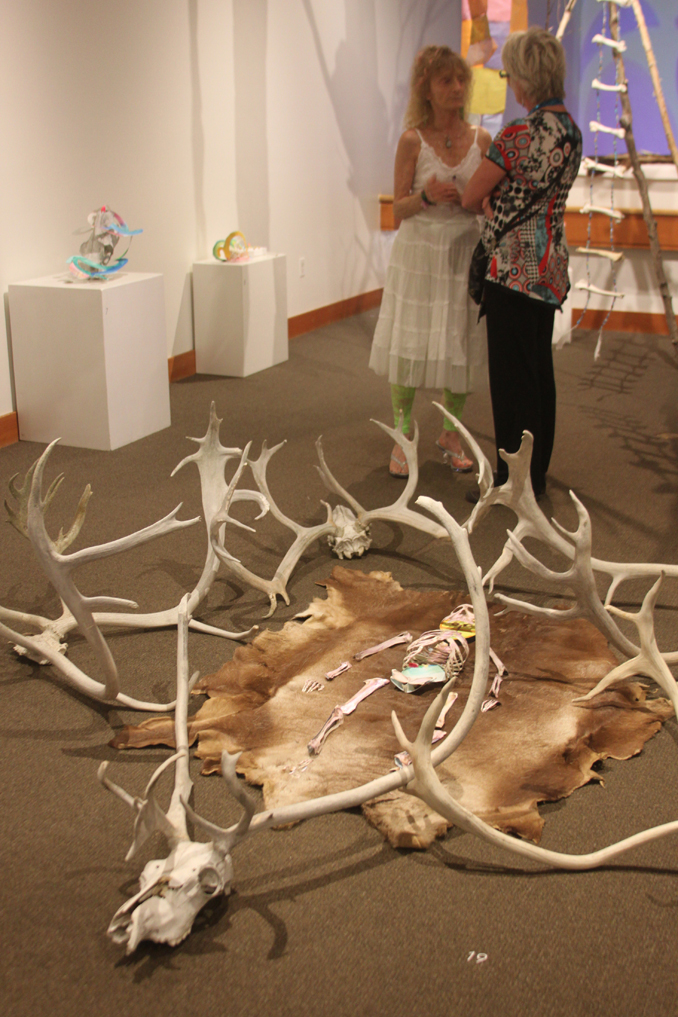If you take a walk through Jo Going’s art exhibit Reliquary at the Pratt Museum, prepare for a paradigm shift.
In Reliquary, Going combines such things as animal bones, teeth, pelts and feathers with bright watercolor paper, beads, sequins and glitter, celebrating the beauty of life through items most people associate with death.
The inspiration for Going’s exhibit was sparked 30 years ago, during a moment when she came across a caribou skeleton on the tundra while living in Interior Alaska.
“I realized then that bones carry the spirit of the animals, a lasting essence of presence, that they are relics, holy and venerable,” Going wrote in her artist statement.
Reliquary had its opening reception June 27 and hosted a large attendance, many in the crowd were greeted personally at the entrance by Going.
“I am very pleased with the reception,” said Going in a later interview. “The energy space was exactly what I had hoped for, a very high vibration that was supportive of the deeper intention of the installation. It was a kind of joyous celebration which I wished as my overall contribution and to leave in my wake.”
Going’s exhibit contains more than 25 intricate pieces that were each assembled in her home, taken down, and then reassembled in the Pratt Museum.
Going worked all day every day from the start of the week on Monday to the opening reception on a Friday.
“It was a lot of work. It wasn’t like I was just hanging up paintings,” she said.
The tallest piece hosts a brown bear skull on top of three white birch branches. A small ladder made up of deer leg bones and multi colored beads descends from the center, with colorful flags made from square pieces of fabric that drape down from the top.
Going collected nearly all of the organic items she used over the 20 years that she lived in Interior Alaska. A few objects were loaned for the purpose of the exhibit that will later be returned to their original keepers.
“For me all the bones are to be honored, it is an honoring. To me they are sacred, they hold the sacred and that is what the show is all about. It is not in any way morbid, but it is a celebration.”
One of the obvious things that makes the exhibit unique is the context in which each art piece is presented. What some may consider gloomy remnants of deceased animals are vibrant representations of life, resurrected through Going’s sparkling sequins, or color-saturated paper.
According to Going, a trained eye will observe something extra.
“The exhibit references art from the time of the Neanderthals to the present. There are visual quotations represented throughout the whole installation on the entire history of art,” she said. “Many of the world’s artists are embedded into the art but it takes a fine eye or someone who’s studied art or who has been to a lot of museums. I think in a small place like Homer a lot of that will be missed but I hope to take this installation to other places outside of Homer.”
Going is an energy healer, dance and yoga instructor and artist that travels all over the world. She is the only artist in Homer with permanent art held at the Museum of Modern Art in New York and the National Museum of Women in the Arts in Washington.
Going said the colors used in her art carry a spiritual pulse and are a way of communicating the energy she sees present in the bones.
Going dressed just as colorfully and was just as delicately ornamented as her artistic pieces. From her light pink highlights, white dress paired with bright green lace tights, and sparkling jewelry, to her heels that flashed different colors with each step, Going reflected her work.
During the opening reception, Going presented three tundra animal poems titled “Storm,” “Friendship” and “Lynx.” Meanwhile, the Pange Lingua hymn Going said she chanted as a child and a selection of tundra animal recordings played in the background.
She then gave the floor to her audience, who were
encouraged to ask questions or make statements about
the exhibit.
One audience member commented on the shadows that strong lighting cast over the pieces. Going responded that shadows are part of the three-dimensional experience.
“One piece grabs my curiosity, number nine, because it is the only piece that has no bones involved. I know you do everything for a reason,” said another attendee.
“Just one piece grabbed your curiosity? I failed miserably then,” Going responded while laughing.
During the question-and-answer session, Going explained that the original piece from the caribou inspiration sat inside of her, waiting for the right context in which to be manifested.
She humorously compared the opening of her art exhibit to birthing a baby.
“I’ve never seen bones so happy,” another audience member said.
Going’s Reliquary exhibit will be on display through Sept. 21 at the Pratt Museum.


